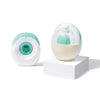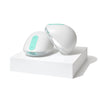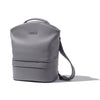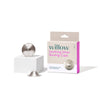Is it possible to pump Colostrum?

TL;DR: Key Takeaways
- What it is: Colostrum is the first "pre-milk" – a thick, concentrated, nutrient-rich fluid your body produces before your mature milk comes in 3-4 days after birth.
- Key Benefit: It's packed with antibodies and nutrients, perfectly designed for your newborn's tiny stomach and developing immune system.
- When to Pump: Wait until after your baby is born. Pumping colostrum during pregnancy can induce labor.
- How to Collect: Hand expression is often more effective than pumping for thick colostrum, helping you save every precious drop.
Storage: Follow breast milk rules: 4 hours at room temp, 4 days in the fridge, or 6 months in the freezer.
Did you know that your breast milk can take a bit of time to start flowing after you have your baby? You can expect to see your breast milk make its grand appearance 3-4 days after the birth of your little one.
Until your breast milk comes to volume, your body will make a substance called colostrum, a pre-milk that’s perfect for getting your baby started. Is it possible to pump thick colostrum? What’s it for? You’ll find answers to all of your questions right here, mama.
What Is Colostrum?
Colostrum is the first breast milk your body will make. In fact, its production begins in mid-pregnancy, around weeks 12-18. It will stick around for the first few days after your baby is born as a “starter” milk, chock full of nutrients, immune factors and fat.
Colostrum is a concentrated form of breast milk that may be yellow, white or clear in color. It’s also thick and sticky, which is much different from the breast milk you’ll make later. There are many benefits of colostrum for your baby:
- Helps strengthen your baby’s immune system
- Provides the right nutrients for baby’s fast growth and development
- Acts as a diuretic to remove meconium before milk volume increases
- Helps your baby learn how to breastfeed slowly
- It’s low volume matches the size of your baby’s newborn stomach - blueberry sized for the first several days
As colostrum is highly concentrated, you won’t make a lot of it. After all, a little bit will go a long way. You may only make 1 to 4 teaspoons of colostrum each day, but rest assured, you’ll always make the right amount for your baby.
When You Should Pump Colostrum
Sometimes babies may not be able to nurse at first due to medical conditions or trouble with latching. And you may struggle with sore breasts after birth. It’s also possible for you to choose not to nurse and instead pump breast milk for your baby. The good news is you can put that pump to good use after the birth of your baby by pumping colostrum if you so choose.
Wait Until Your Baby Is Born to Pump Colostrum
It’s important to note that pumping colostrum before your baby is born can be potentially dangerous. In some cases, pumping colostrum during pregnancy can induce labor which can lead to premature birth.
Wait until after your baby is born to pump unless your healthcare provider tells you otherwise. You’ll have plenty of colostrum to pump and store once your baby is here.
Willow 360™ Wearable Breast Pump
Willow 360™ Wearable Breast Pump
Willow 360 is designed with a zero-gravity latch to give you 360° of leak-proof mobility. It's the hands-free breast pump that changed the game.
How to Remove & Store Colostrum
Ready to gather that liquid gold for your baby, mama? If so, there are two main ways you can do so: via breast pump or hand express.
Pump vs. Hand Express
If you already have an electric breast pump, you can hook it up to both breasts to remove colostrum from each. Or, you can try to do one breast at a time, depending on the type of pump you have. You can also try a manual pump that may give you more control.
Since your breasts don’t hold a high amount of colostrum and it’s particularly thick, a pump may not yield as much as hand expressing will. Research has shown that expressing colostrum with your hand can help you save every last drop versus trying to pump into a container.
How to Hand Express Colostrum
Quick reference guide: How to Hand Express Colostrum
- Wash your hands with soap and water first.
- Massage your breasts to jumpstart the letdown process.
- Place your hand in a c-shape around your breast with your thumb at the outer edge of the areola.
- Squeeze gently and move your hand toward your nipple.
- Collect drops in a spoon, then transfer to an airtight container or syringe.
Colostrum Storage Guidelines:
- Room Temperature: Up to 4 hours
- Refrigerator: Up to 4 days
Freezer: Up to 6 months
To hand express, make sure you wash your hands with soap and water first. Then, start massaging your breasts to jumpstart the letdown process. Place your hand in a c-shape around your breast with your thumb at the outer edge of the areola. Then, squeeze your hand gently and move toward your nipple.
After a few seconds, you should start to see colostrum forming at the nipple. Gather the colostrum in a spoon, then place it in an airtight container or jar. When you’re ready to feed your little one, you can suck the colostrum into a syringe or a small cup and feed your baby that way.
You should follow the same storage guidelines as you would for breastmilk. Colostrum can be stored at room temperature for up to 4 hours or in the refrigerator for up to 4 days. You can also store your colostrum in the freezer for up to 6 months.
FAQs
-
Q: Is Pumping Colostrum Before Birth Safe?
A: Again, pumping colostrum before the birth of your baby may induce labor. It’s best to wait until after birth to start trying to pump. Of course, there are always exceptions, depending on you and your baby’s needs. -
If you feel the need to pump and store colostrum before your baby is here, please speak to your healthcare provider about the risks first.
-
Q: Does Colostrum Mean You’re About to Go Into Labor?
A: Nope! Your body will start making colostrum as early as the first trimester to prepare your body for your baby. You may even notice your breasts leaking some colostrum here and there. This isn’t a cause for concern. It simply means your body is doing what it can to prepare for breastfeeding in advance. -
Q: Can I Mix Colostrum With Formula?
A: If you choose to formula feed your baby, it’s still a great idea to express your colostrum. Be sure to mix up your bottle of powdered formula first and never use breast milk as the water component. -
Once you mix your bottle, add your colostrum and mix. This is a great way to add nutrients to your baby’s first meals.
-
Of course, it’s important to note that formula must be disposed of within 24 hours of making the bottle to prevent bacteria growth. If you mix in your liquid gold and your baby doesn’t finish the bottle, you may lose those precious drops.
-
You can still give your baby colostrum with a syringe or small cup while formula feeding to ensure your baby receives every last drop of nutrient-rich colostrum.
Tags Used



















